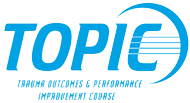| 7:00 AM – 7:50 AM |
STN Annual Member Meeting & Breakfast
Amy Krichten, MSN, RN, CEN, TCRN, STN President 2022
|
| 8:00 AM – 8:45 AM |
President's Address
Presenters: Linda Reinhart, MSN, RN, CNS, CCRN, TCRN, STN President 2023
Amy Krichten, MSN, RN, CEN, TCRN, STN President 2022
|
| 8:45 AM – 9:45 AM |
Keynote Address: How Healthcare Professionals Drive Social Change!
Joseph Sakran, MD
Moderator: Linda Reinhart,MSN, RN, CNS, CCRN, TCRN
|
| |
Dr. Joseph Sakran is a trailblazer and nationally respected voice in the firearm injury prevention movement. He is currently Director of Emergency General Surgery, Associate Professor of Surgery and Nursing, and Vice Chair of Clinical Operations at The Johns Hopkins Hospital in Baltimore, Maryland. As a survivor of firearm-related violence, he was motivated to become a surgeon, researcher, and advocate in firearm injury prevention. At every turn of his career, he has used his personal experience and substantial skills to push a new frontier primarily in service of marginalized communities in the United States.
|
| 9:45 AM – 10:00 AM |
Refreshment Break in Exhibit Hall
|
| 10:00 AM – 11:00 AM |
Concurrent Sessions Round 1
|
| |
Untapped Opportunity: Utilizing Your Post Survey Report to Elevate Your Trauma Program
Presenter: Amy Koestner,MSN, RN
Moderator: Jami Blackwell, RN, BSN, MBA, BS, TCRN, CEN
The ACS post survey report identifies criteria deficiencies (CD), strengths, opportunities for improvement (OFI), and recommendations. Most trauma programs review these areas and develop action plans related to the identified CDs and OFIs. Review of the surveyors case write-ups along with the center's evaluation of their own survey preparation process can provide valuable insight to drive the program to a higher level of performance and best practice while enhancing skill sets across the team. Objectives
- Demonstrate dissection of a center's ACS survey to identify programmatic opportunities
- Explain use of team retreats during ACS survey preparation and post survey to engage TPM, TMD, PI and registry staff engagement and awareness for change
- Utilize 2022 ACS standards to further align center performance
- Show effectiveness of retreat agendas, homework, and survey to drive program change and engagement
|
| |
Fall From Height: Gravity Always Wins
Presenter: Megan Quintana, MD
Moderator: Heather Sieracki, MSN, RN, CSTR
This lecture addresses the initial management for the patient who has sustained blunt trauma after a fall from height. We will focus on the management of complex pelvic fractures including initial resuscitation and stabilization measures. We will discuss principles of hemorrhage control to include pelvic stabilization devices, aortic occlusion methods, and definitive management. We will also discuss the benefit of massive transfusion protocols, balanced resuscitation, TXA and whole blood. Objectives
- Identify the unique anatomic characteristics of pelvic trauma that increase the potential for hemorrhage.
- Describe the initial principles in the management of severe pelvic trauma.
- Utilize tips and information to provide hemorrhage control and resuscitation to the injured patient with a pelvic injury.
|
| |
Identifying Trends in Community Gun Violence Using a Trauma Registry
Presenter: Samantha Baker, AS, CAISS
Moderator: Tyler Brignac, RN, BSN
By accessing readily available data and reports from the trauma registry, trends in community gun violence can be identified and tracked, supporting injury prevention programs and initiatives.Internal program resource allocations can be more strategically assigned and can drive program growth. External injury prevention collaborations with local government entities can be supported by providing a better overall picture of targeted interpersonal firearm violence metrics. Objectives
- Understand additional uses for trauma registry data outside of clinical care/best practices
- Learn tracking and trending of various trauma mechanisms in a given community, including firearm violence.
- Identify ways to use trauma registry data as support for internal /external trauma program growth.
|
| |
Delirium in the ICU: Is the CAM Tool Right for You?
Presenter: Jacqueline Walsh, RN, BSN, MSN
Moderator: Valerie Brockman, MSN, RN, CAISS, CPHQ, CSTR
The CAM-ICU is a diagnostic algorithm to assess for delirium by identifying the four features of this disorder that distinguishes it from other forms of cognitive impairment. These four features are: acute onset or fluctuating course, inattention, altered level of consciousness, and disorganized thinking. Depending on how many features are present will determine if a patient is exhibiting signs of Delirium.
The main objective was to come up with a way to decrease delirium within our SICU to provide better patient outcomes, decrease unplanned extubations, and or improve our patients’ quality of life post-discharge. After the research had been completed, two goals were created for this project. The first was to identify patients that are positive using the CAM tool. The second goal was to manage delirium using the ABCDE protocol.
|
| 11:10 AM – 12:10 PM |
Concurrent Sessions Round 2
|
| |
Trauma Induced Coagulopathy and Hemostatic Strategies
Presenter: Paul Thurman, PhD, RN, ACNPC, CCNS, CCRN
Moderator: Tracy Cotner-Pouncy, BSN, RN, TCRN
Bleeding is a potentially controllable complication leading to early traumatic death. Understanding hemorrhage and the subsequent coagulopathy provides opportunities to assess and halt hemorrhage. This session will explore the latest evidence using case studies for physical assessment and diagnostic interpretations to evaluate traumatic coagulopathy and making appropriate mechanical and pharmacological interventions to achieve hemostasis. Objectives
- The participant will interpret assessment and diagnostic data to evaluate traumatic coagulopathy
- The participant will develop an intervention plan for hemorrhage based on their interpretation of assessment and diagnostic data.
- The participant will consider the uses of mechanical and pharmacological intervention to achieve hemostasis.
|
| |
The Keys to Building a Successful Trauma Resuscitation Nurse Team
Presenter: Kayla Whiteaker, MSN, RN, CEN, TCRN, NE-BC
Moderator: Vicki Moran, PhD, RN, CNE, MPH, APHN-BC, CDE, TNS
In this session, attendees can expect to hear a Trauma Program Director’s journey through joining an elite team as a Trauma Resuscitation Nurse (TRN), transitioning from the bedside into a Director role leading that same team, and then joining another hospital system and starting her own TRN Team. Attendees will hear about the variety of ways these programs can be set up, the benefits of these elite teams, and the potential pitfalls. Objectives
- Participants will be able to discuss different ways in which a Trauma Resuscitation Nurse team could be structured.
- Participants will be able to understand the benefits of having a Trauma Resuscitation Nurse team.
- Participants will be able to discuss and understand the ways in which a bedside nurse could prepare him/herself as a potential candidate for a Trauma Resuscitation Nurse team role.
|
| |
After the Bleeding Stops: How Psychological Effects Burden Patients with Non-fatal Gunshot Wounds
Presenter: Suzanne Sherwood, BSN MS RN TCRN
Moderator: Stephanie Vega, MBA, BSN, RN, CCRN-K, CSTR
The damage of firearm violence in the United States is a serious Public Health concern. Patients who survive bullets that pierce their bodies may never fully recover from the emotional effects of their wounds. Studies indicate improved patient outcomes when providers identify and treat patients’ psychological burdens that may impede their recovery. This offers a window of opportunity for nurses to listen, support, and create an atmosphere of stability and hope for patients and their families. Objectives
- Examine challenges nurses face in their assessment of patients who experience psychological effects specific to non-fatal gunshot wounds.
- Develop an interdisciplinary plan of care to prevent long-term psychological complications and recidivism in patients experiencing nonfatal gunshot wounds.
- Integrate the knowledge of current studies on gun violence as a public health crisis into the patient’s short and long-term treatment plan during their recovery.
|
| |
A Guide to Pediatric MTP
Presenter: Tiffany Taylor, MSN, MBA, RN, TNS, TCRN, CPEN
Moderator: LeAnne Young, MSN RN TCRN
Pediatric MTP is an infrequent but high acuity event, even in the busiest Trauma Centers. Staff often voice concerns regarding familiarity and competency with the process since its such a low frequency event. Pediatric MTP is also not a "one size fits all" event, even though most trauma centers have "one size fit all" protocols. This session is an overview of how an urban Pediatric Level I Trauma Center implemented a project to increase comfort during MTP as well as improve volumes given. Objectives
- Learners will be able to identify blood components, products, and volumes used during pediatric massive transfusion
- Learners will be able to identify ways to review pediatric MTP and identify opportunities for PI projects.
|
| 12:00 PM – 2:00 PM |
Lunch in Exhibit Hall
Exhibit Prize Drawing: 1:45pm
|
| 2:00 PM – 3:00 PM |
Concurrent Sessions Round 3
|
| |
Acute Traumatic Cervical Spinal Cord Injury
Presenter: Karen McQuillan, MS, RN, CNS-BC, CCRN, CNRN, TCRN, FAAN
Moderator: Regina Krell, MS, BSN, CEN, TCRN
This presentation will explain spinal cord injury pathophysiology which provides the scientific basis for assessment strategies and therapeutic interventions. Abnormal neurologic assessment and monitoring findings will be interpreted. Evidence-based rationale for various therapies currently used to treat patients with cervical spinal cord injury will be described. Therapeutic interventions under investigation will be reviewed. Objectives
- Differentiate cervical spinal cord injuries based on type of lesion and degree of functional loss.
- Interpret abnormal assessment findings seen with patients that have sustained a cervical spinal cord injury.
- Formulate a plan of care, which includes current recommended evidence-based interventions for the patient who has sustained an acute cervical spinal cord injury and list two interventions being investigated for future use.
|
| |
Registrar Accuracy Improvement Tool
Presenter: Norrie Bradley, RN, BSN
Moderator: Debra Kitchens, MBA, BSN, RN, CEN, TCRN, NRP
Trauma centers need the most accurate data to properly assess the care given each patient and measure that against current standards. TQIP data analysis is an integral part of care for patients and gives providers a comprehensive picture of trauma management. Due to myriad of factors, data loss occurs in the best of facilities. This doesn't have to happen! Our tool helps identify lost data before reports are submitted and reduces the risk of feedback based on incorrect data submissions. Objectives
- Understand how to use TQIP or other data analysis feedback to identify areas of needed improvement in their program.
- Be able to develop and implement an accuracy improvement tool, based on the specific needs at their facility.
- Have the skills to use the tool for personal job performance improvement or coaching for trauma registry staff.
|
| |
The Use of a Nurse-administered Trauma-focused Treatment to Lessen the Effects of PTSD and Depression After an Injury
Presenter: Kelly Urban, PhD, MEd, RN, CCRN-K, TCRN
Moderator: Lisa Buckman, MBA, BSN, RN, TCRN, CSTR
PTSD after injury is one of the strongest correlates of post-injury quality of life. Evidence-based nurse-administered trauma-focused treatments have been identified to lessen the effects of PTSD and depression. This session will include the need for trauma centers to implement a PTSD screening and intervention protocol, lessons learned and steps undertaken for implementation of a nurse-administered treatment for trauma patients during a follow-up appointment after discharge from the hospital. Objectives
- The participant will be able to identify the key stakeholders to implement a nurse-administered treatment for PTSD.
- The participant will be able to verbalize potential barriers to implementing a new treatment.
- The participant will be able to verbalize the importance of a screening and intervention protocol for PTSD.
|
| |
Incorporating a Multidisciplinary Approach to Primary Review in the Performance Improvement Process
Presenters: Susanne Edwards, BSN
Alicia Cochran, RN, BSN
Moderator: Jessica Cofran, MSN, RN, TCRN, CSTR
The purpose of this session is to explain the performance improvement process with emphasis on the primary and secondary review sections. By integrating different specialties that can provide insight into possible performance issues, care is seen across the care continuum, not just in the acute phase. The multidisciplinary approach also assists other disciplines in understanding the quality indicators to which trauma patients are held in the PI process. Objectives
- Overview of the performance improvement process.
- Highlighting the primary and secondary phases of the PI process.
- Explanation of incorporating different disciplines in the primary review process; and why it is helpful to identify PI issues.
- Barriers faced when including other disciplines and how to overcome those barriers.
- Data keeping and the follow-up process when a PI issue is identified.
- Process for merging data between primary and secondary review.
|
| 3:15 PM – 4:15 PM |
Plenary Session: Preventing Workplace Violence: One Trauma Center’s Experience
Kristen Chreiman, MSN, RN, TCRN, CCRN-K, Lisa Triantos, MSN, RN, CEN, NE-BC, LeighAnn Mazzone, MSN, RN, CEN, Esther Wood, MSN, RN-BC, and Julie Seman, MSN, RN, CCRN
Moderator: Dan Kiff, RN, MN |
| |
Workplace violence is an act or threat of violence by patients, visitors or other employees. The rising rate of workplace violence against healthcare workers nationally and internationally has negatively impacted the nursing workforce, leading to burnout and recruitment and retention challenges. Join our panelists in a discussion as they share innovative methods for mitigating workplace violence and supporting nurses across three different care settings within an urban, Level 1 Trauma Center.
Objectives
- Describe the increased prevalence of WPV and its impact on healthcare workers’ performance across the continuum of care.
- Improve preparation and prevention strategies to manage incidents, competencies and required reporting as it relates to WPV.
- Understand how workplace violence can negatively impact clinician’s mental health, perceptions of work place safety and retention.
|
| 4:15 PM |
Day 1 Closing Remarks
Carrie Chismarich, MA, BSN, RN, TNS, TCRN |
| 5:00 PM - 7:00 PM |
Poster Session
Poster Judging & Participant Viewing (Optional CE)
|




 Amy Koestner, MSN, RN
Amy Koestner, MSN, RN This course will feature expert speakers covering topics specific to the body of knowledge in trauma nursing across the continuum of care, from injury prevention through reintegration to home.
This course will feature expert speakers covering topics specific to the body of knowledge in trauma nursing across the continuum of care, from injury prevention through reintegration to home.